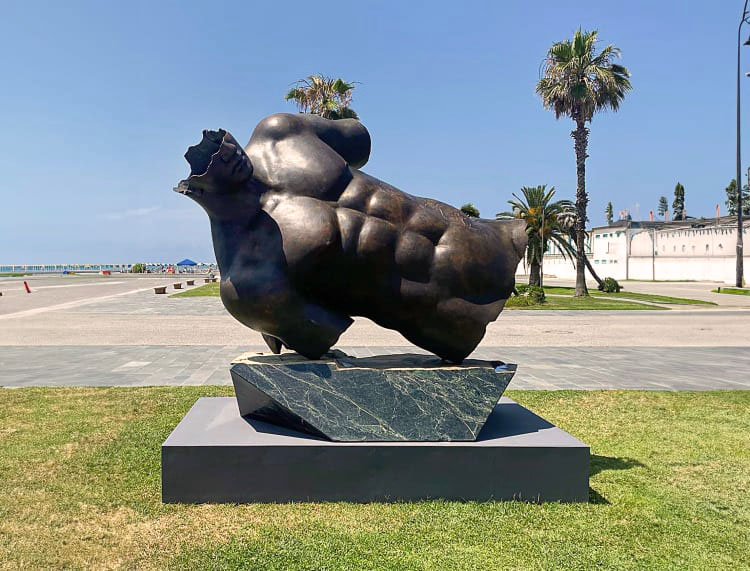
Igor Mitoraj’s Most Famous Sculptures
If you’ve ever walked through a European piazza and suddenly found yourself standing before a monumental bronze face, its features serene yet fractured as if unearthed from a lost civilization, chances are you’ve encountered the work of Igor Mitoraj.
Mitoraj’s sculptures are both ancient and modern , their classical proportions whispering of Greece and Rome, yet their broken forms speaking to a world acquainted with ruin, impermanence, and beauty in decay. His work bridges the gap between past and present, exploring the fragility of human existence with an elegance few sculptors achieve.
This is the story of Igor Mitoraj: his most famous sculptures, his techniques, the markets that collect his work, and the far-flung locations where his monumental figures stand sentinel.
Who Was Igor Mitoraj?
Born in 1944 in Oederan, Germany, to a Polish mother and a French father, Igor Mitoraj’s early life was marked by the upheaval of World War II. His family returned to Poland, where he grew up in Kraków, a city steeped in history and art. He studied painting at the Academy of Fine Arts in Kraków under Tadeusz Kantor, one of Poland’s most influential avant-garde artists.
In the late 1960s, Mitoraj moved to Paris to continue his studies at the École nationale supérieure des Beaux-Arts. His early career was primarily as a painter, but by the mid-1970s, a pivotal trip to Mexico shifted his focus entirely to sculpture. The pre-Columbian ruins he encountered there, weathered yet enduring, deeply influenced his vision.
From then on, Mitoraj became known for large-scale sculptures, often depicting human figures or faces with parts missing, cracked, or seemingly incomplete , not out of neglect, but as a deliberate metaphor for vulnerability and imperfection.
What Is Igor Mitoraj Known For?
Igor Mitoraj’s signature style blends classical figuration with deliberate fragmentation. His sculptures often feature:
Enormous heads with eyes closed, evoking calm introspection.
Torsos without limbs, echoing ancient Greek and Roman statuary damaged over time.
Bandaged faces or bodies, hinting at themes of suffering, repair, and resilience.
Surfaces with patina , bronze and marble often treated to look aged, as though they’ve survived centuries underground.
At the core of Mitoraj’s work is a philosophical idea: human beauty is inseparable from human fragility. His fractured figures are not ruins of perfection, but rather perfection redefined , shaped by the passage of time.
Igor Mitoraj’s Most Famous Sculptures
Though Mitoraj created hundreds of works over his career, several have become iconic, photographed endlessly and instantly recognizable.
Eros Bendato (Eros Bound)
Perhaps his most famous work, Eros Bendato is a monumental bronze head lying on its side, eyes closed, mouth slightly open, and wrapped in bandages.
One of the most famous casts is in Kraków’s Main Market Square, where visitors can walk inside the hollow head. The sculpture speaks to the blindness of love, vulnerability, and the passage from myth into modernity.
Testa Addormentata (Sleeping Head)
A giant bronze face, serene yet incomplete, as if torn from a colossal statue of antiquity. Versions of Testa Addormentata can be found in several European cities, including Rome and Paris.
Centurione I
A helmeted head reminiscent of a Roman centurion, this piece fuses military power with a sense of stillness and introspection. The fragmented form makes it seem like an archaeological find.
Ikaria
Inspired by the Greek myth of Icarus, Ikaria depicts a winged human form , beautiful, but fractured, suggesting both the glory and the downfall of ambition.
Tindaro Screpolato
A massive bronze head with fissures running across the face, as if the surface itself has been shattered by time. One of its most famous placements is in the Boboli Gardens in Florence.
Tête d’homme
This sculpture presents a masculine head with clean, strong features but, as always, interrupted by cracks or missing sections, conveying both strength and vulnerability.
How Igor Mitoraj Made His Sculptures
Mitoraj’s process combined traditional craftsmanship with a conceptual twist.
Initial Sketches & Maquettes
He began with drawings, exploring proportions and mood. Then he created small-scale clay or plaster models, called maquettes, to refine the composition.Material Choice
His primary materials were bronze and marble:Bronze: Cast using the lost-wax process (cire perdue), an ancient technique where a wax model is encased in a mold, melted away, and replaced with molten metal.
Marble: Carved by hand, often from Carrara marble in Italy, which has been used since Roman times.
Surface Treatment
Bronze works were patinated to evoke age, with green or brown oxidization patterns. Marble pieces might be polished in parts and left rough in others, enhancing contrast.Fragmentation as Design
Unlike ancient ruins, which lose parts by accident, Mitoraj intentionally designed missing limbs, cracked faces, or hollow interiors. This deliberate incompletion created the sensation of encountering relics from a forgotten civilization.Scale
Many of his sculptures are monumental, requiring teams of artisans and foundries to produce. The scale invites public interaction , people can stand inside them, lean against them, or walk around them like architectural elements.
The Value of Igor Mitoraj’s Sculptures
Mitoraj’s works are highly sought after in the art market. Prices vary widely depending on size, material, edition, and provenance.
Small bronze casts (30–50 cm) have sold at auction for $20,000–$60,000.
Medium-sized works (1–2 meters) often fetch $100,000–$300,000.
Large public-scale bronzes can exceed $1 million.
Marble pieces tend to command higher prices due to the labor and material cost.
Auction records show that Mitoraj’s works continue to appreciate, especially after his passing in 2014. Collectors range from museums and cities commissioning public art, to private individuals who place his sculptures in gardens, estates, and corporate headquarters.
Where to See Igor Mitoraj’s Sculptures
Mitoraj’s monumental sculptures are scattered across the globe, from bustling city squares to serene gardens.
Italy
Piazza del Carmine, Florence – Tindaro Screpolato in the Boboli Gardens is one of his most famous installations.
Pompeii Archaeological Park – In 2016, a major exhibition placed Mitoraj’s sculptures among the ruins, creating a haunting dialogue between ancient and modern fragments.
Piazza Monte Grappa, Rome – Home to several monumental heads.
France
Paris, La Défense – The business district houses several of his works, juxtaposed with modern skyscrapers.
Saint-Tropez – Coastal installations that contrast with the Mediterranean backdrop.
Poland
Kraków Main Market Square – The cast of Eros Bendato here is one of the city’s most photographed landmarks.
Kraków’s Planty Park – Home to additional works, celebrating his Polish heritage.
United Kingdom
Canary Wharf, London – Hosts several of his monumental bronze heads.
United States
Atlanta, Georgia – The Atlanta Botanical Garden has exhibited his works in outdoor sculpture displays.
Palm Desert, California – Several private and public collections feature his monumental pieces.
Other Notable Locations
Lugano, Switzerland – Permanent public displays along the lake.
La Défense, France – Several sculptures integrated into the city’s modernist architecture.
Puerto Banús, Spain – Outdoor works in the marina.
Because Mitoraj’s works are often created in limited editions, multiple casts of the same piece may exist in different countries, making it possible to encounter Eros Bendato or Testa Addormentata in more than one location.
The Philosophical Layer
Mitoraj once said:
“Beauty is inseparable from decay. To show one without the other is to lie.”
His sculptures are meditations on time. The classical references remind us of civilizations that once thought themselves eternal. The cracks and missing parts acknowledge the inevitability of decline , yet in that decline, something new emerges: a different kind of beauty, one that embraces imperfection.
There’s also a psychological dimension. The blindfolded and bandaged faces suggest restraint, silence, or wounds , both literal and emotional. Viewers project their own narratives into the voids and fractures, making his work as much about the observer as the observed.
Igor Mitoraj Legacy
Igor Mitoraj passed away in 2014 in Paris, leaving behind a body of work that has only grown in influence. His sculptures occupy an unusual space: instantly accessible to the casual viewer because of their beauty, yet deeply layered for those who seek meaning in their fractured forms.
Today, his works continue to be installed in public spaces, often as temporary exhibitions that later become permanent because cities fall in love with them. They bridge centuries, reminding us that the stories of humanity are always written in fragments.
Quick Reference: Igor Mitoraj at a Glance
Born: 1944, Oederan, Germany
Died: 2014, Paris, France
Nationality: Polish-French
Known for: Monumental bronze and marble sculptures blending classical beauty with deliberate fragmentation.
Materials: Bronze, marble (especially Carrara)
Themes: Time, decay, beauty, vulnerability, mythological references.
Famous Works: Eros Bendato, Testa Addormentata, Centurione I, Ikaria, Tindaro Screpolato.
Auction Range: $20,000 to over $1 million.
Public Installations: Kraków, Florence, Rome, Paris, London, Atlanta, Pompeii, and more.
Standing Before a Fragment
Encountering a Mitoraj sculpture is a quiet yet powerful experience. Whether in a crowded square or a secluded garden, his works have a way of halting movement, drawing the eye, and making the viewer aware of both presence and absence. They are at once relics and contemporary art, reminders of civilizations gone and warnings of our own impermanence.
In an age that often chases perfection, Mitoraj’s fractured figures remind us of the opposite truth: that imperfection is the most honest form of beauty , and that sometimes, what is missing speaks louder than what remains. image/ continiarte




